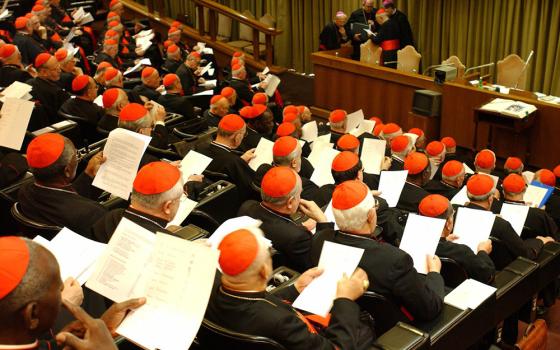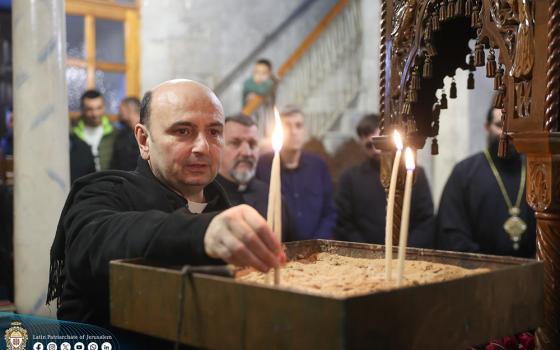
Water remains on a window sill in a middle school classroom Sept. 28 at St. Mary School in Wilmington, North Carolina, the first Catholic school in the state. The school sustained significant damage from Hurricane Florence. (CNS/Bob Roller)
As the liturgical Season of Creation for 2018 draws to a close, the serious need for prayer, study and widespread action in response to the destructive threats of climate change has never before seemed so urgent.
Through all that I have heard through the years about the dangers of climate change and ecological degradation, I have never quite been able to imagine a possible end to human life or destruction of life as we know it on the planet. Until now.
In the aftermath of Hurricane Florence and Typhoon Mangkhut, the aerial views of whole cities flooded brought back images of whole Mayan and Incan cities overgrown now by jungle, human life and developed civilizations completely and mysteriously gone. How many more "once-in-a-century" or "once-in-a-thousand-years" storm or fire disasters (that are now striking practically every year or every few years) will it take before people will no longer have the will or ability to rebuild?
This year, for the first time I can recall, scientists are warning explicitly that climate change is not a future danger we need to try to prevent. Climate change is here now and will continue to worsen. It is the new normal.
As if to underscore that reality, a recent lead-page section of a local Ohio newspaper, The Toledo Blade, included these stories about a week after Florence and Mangkhut:
- Tilapia are being used to try to control duckweed and algae overgrowth, driven by warming temperatures and farm runoff that is choking local lakes (Page 1).
- Puerto Rico marks one year since Hurricane Maria savaged the island and is still struggling to recover (Page 2).
- Floodwaters are slowly receding in the Carolinas; some rivers have not yet crested a week after the storm struck; officials are trying to head off other disasters; damage from Hurricane Florence threatens the environment (Page 3).
- Temperatures could now be sufficient, based on current temperatures and archaeological data from about 125,000 years ago, to melt a major part of the East Antarctic ice sheet in the Wilkes Subglacial Basin. This region is roughly the size of California and Texas combined, and contains enough water to raise sea levels everywhere more than 10 feet (Page 4).
- There is a serious drop in the swarms of the most beneficial flying insects of summer that has scientists deeply concerned: native bees, moths, butterflies, ladybugs, lovebugs, mayflies and fireflies. Last year a German study found an 82-percent midsummer decline in the number and weight of bugs captured in traps in 63 nature preserves, compared with 27 years earlier. Scientists are pretty sure that around the planet there are fewer insects that are crucial to the pollination and production of 80 percent of what we eat (Page 6).
- The lead editorial raised questions about regional water, expressing concern over the importance of regional water issues to the city and surrounding region (Page 8).
Climate change is here, now, and is still worsening. Its threats to life as we know it are coming into clearer and more frightening view.
Is Earth trying to teach us in its own way what Jesus tried to teach his apostles when he told them: "I will be handed over to people who will kill me"?
This prediction of his Passion was central in the Gospels of both the third and fourth Sundays of the Season of Creation this year. Jesus promised to rise three days after his death. Still, the Twelve, led by Peter, assumed that as God’s special anointed one, Jesus would be protected and would emerge from conflicts with the Jewish leaders and the Roman occupiers as victor and savior. They couldn’t understand what he was trying to tell them, but they were afraid to ask.
Is the message from Earth to us this year a warning about its suffering and dying? Is it a message we don’t understand and are afraid to really believe possible? Scientists are warning that we are already into the sixth great mass extinction of life on Earth, the biggest since the dinosaurs 66 million years ago, and the first one caused principally by humans. From the evidence of the previous five extinctions etched in our planetary archaeology, Earth’s resurrection could surely take place, but it would most likely take hundreds of thousands, if not millions, of years.
In his encyclical "Laudato Si, on Care for Our Common Home," Pope Francis identified the global economy — structured on competition that drives consumption and requires constant economic growth on a planet with limited resources — as obviously destructive for the planet’s ecology, including the human community. The human community must stop assuming that we live on a planet with limitless resources.
On Aug. 1, less than two months ago, I wrote about Earth Overshoot Day, highlighting the fact that the human community had consumed in just seven months the renewable resources that it will take the planet a full year to replenish. And Earth Overshoot Day is coming earlier every year. It is impossible for this dynamic to continue.
Those economic patterns are also the drivers of growing inequality around the planet that promises increasing social crises and conflict. When the average worker for a major U.S. corporation makes about $28,000 a year while its CEO makes $28,000 every nine seconds, social crisis seems inevitable. While that is an extreme example, the competitive structures of the global economy are driving global inequality, leaving more and more people in desperate need of resources on this limited planet and aggravating what Pope Francis has described as one complex and interrelated global economic, ecological and social crisis.
It is abundantly clear: Climate change is here.
Its devastating threats are more and more apparent. It is being driven by some of the most basic social and economic systems by which we are living on Earth today. And it is perhaps progressing much more quickly than our analytic models have predicted.
Though the 2018 liturgical Season of Creation comes to a close Oct, 4, it is urgent that communities of faith around the planet carry forward the revelation, inspiration, growth in spiritual energies and global collaboration that the season has nurtured in a renewed commitment. It is essential that the human family reverse the dynamics driving climate change, ecological depletion, injustice and violent conflict as people struggle to survive. We must move into our immediate future deepened and transformed.
What might that look like? Reflecting on the Sunday liturgical texts from this year’s Season of Creation, I might sum it up in this way:
Ongoing contemplation of the beauty and wonder of creation must continue to feed our appreciation, gratitude, love of and passion to take care of the planet on which we are blessed to live. We take care of what we come to appreciate, are grateful for and love.
Advertisement
Remembering that God did not spare Jesus from the terrible rejection, suffering and death that the religious leaders of his people condemned him to, we need to take with utmost seriousness the threats from the ecological and social crisis we are caught up in. In the words of Jesus, it is “thinking not as God does but as humans do” (Mark 8:33, the Gospel reading for the third Sunday of the Season of Creation 2018) to expect that God would somehow come in to save creation from the natural effects of our destructive activities.
We need to pray for ever-deepening trust that the awesome God behind and throughout the cosmos is accompanying us with love through all that may lie ahead — as God was faithful to Jesus through his suffering and death — holding before us the promise of resurrection.
Then we need to take up with renewed energy the call to be prophets to our time, calling everyone we can touch through word and living example into new ways of living together as one human family within the Earth community, working to evolve together the next emerging stage of the New Creation.
[Jesuit Fr. James E. Hug serves as sacramental minister for the Adrian Dominican Sisters and writes on spirituality for social transformation. His blog, "Truth that does Justice," can be found on the website for the Dominican Center: Spirituality for Mission.]






